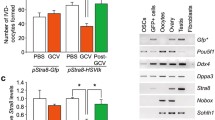Abstract
Objective
The ovarian-specific promoter, OSP-1, which was cloned from the transcript of a rat retrovirus-like element specifically expressed in ovarian tissue, was tested for its ability to drive ovary-specific transcription in transgenic mice.
Methods
Transgenic mice were generated with the lacZ reporter gene (OSP-lacZ) or the early region of SV40 virus (OSP-TAg) placed under the control of the OSP-1 promoter. OSP-lacZ and OSP-TAg transgenic animals were examined, respectively, for the expression of lacZ (OSP-lacZ) or the development of tumors (OSP-TAg).
Results
The expression of lacZ in the resulting OSP-lacZ mice was restricted to the ovary as determined by X-gal staining of multiple organs. Immunohistochemical detection of β-galactosidase showed lacZ expression mainly in the granulosa cells and ovarian surface epithelial cells. OSP-TAg mice developed tumors in a variety of tissues, including unilateral granulosa cell tumors in two of three female founder mice. In the contralateral ovary of one mouse with a granulosa cell tumor, there wee alterations in the ovarian surface epithelial cells suggestive of preneoplasia.
Conclusions
Although the OSP-1 promoter was able to restrict reporter gene expression to the ovary in transgenic mice, the expression of TAg in the OSP-TAg mice resulted in ovarian tumors as well as tumors in numerous other organs. This indicated that although transcription from the OSP-1 promoter occurs predominantly in the ovary, this promoter is sufficiently leaky in cells in other tissues to permit their tumorigenic conversion by SV40 TAg.
Similar content being viewed by others
References
Ong A, Maines-Bandiera SL, Roskelley CD, Auersperg N. An ovarian adenocarcinoma line derived from SV40/E-cadherintransfected normal human ovarian surface epithelium. Int J Cancer 2000;85:430–437.
Abdollahi A, Godwin AK, Miller PD, et al. Identification of a gene containing zinc-finger motifs based on lost expression in malignantly transformed rat ovarian surface epithelial cells. Cancer Res 1997;57:2029–2034.
Roby KF, Taylor CC, Sweetwood JP, et al. Development of a syngeneic mouse model for events related to ovarian cancer. Carcinogenesis 2000;21:585–591.
Orsulic S, Li Y, Soslow RA, Vitale-Cross LA, Gutkind JS, Varmus HE. Induction of ovarian cancer by defined multiple genetic changes in a mouse model system. Cancer Cell 2002;1:53–62.
Kananen K, Markkula M, Rainio E, Su JG, Hsueh AJ, Huhtaniemi IT. Gonadal tumorigenesis in transgenic mice bearing the mouse inhibin alpha-subunit promoter/simin virus T-antigen fusion gene: characterization of ovarian tumors and establishment of gonadotropin-responsive granulosa cell lines. Mol Endocrinol 1995;9:616–627.
Dutertre M, Gouedard L, Xavier F, et al. Ovarian granulosa cell tumors express a functional membrane receptor for anti-Mullerian hormone in transgenic mice. Endocrinology 2001;142:4040–4046.
Godwin AK, Miller PD, Getts LA, et al. Retroviral-like sequences specifically expressed in the rat ovary detect genetic differences between normal and transformed rat ovarian surface epithelial cells. Endocrinology 1995;136:4640–4649.
Selvakumaran M, Bao R, Crijns AP, Connolly DC, Weinstein JK, Hamilton TC. Ovarian epithelial cell lineage-specific gene expression using the promoter of a retrovirus-like element. Cancer Res 2001;61:1291–1295.
Hanahan D. Heritable formation of pancreatic beta-cell tumours in transgenic mice expressing recombinant insulin/simian virus 40 oncogenes. Nature 1985;315:115–122.
Sambrook J, Fritsch EF, Maniatis T. Molecular cloning: A laboratory manual. 2nd ed. Cold Spring Harbor, Maine: Cold Spring Harbor Laboratory Press, 1989.
Cohen-Tannoudji M, Vandormael-Pournin S, Drezen J, Mercier P, Babinet C, Morello D. lacZ sequences prevent regulated expression of housekeeping genes. Mech Dev 2000;90:29–39.
Saenz-Robles MT, Sullivan CS, Pipas JM. Transforming functions of simian virus 40. Oncogene 2001;20:7899–7907.
Author information
Authors and Affiliations
Additional information
This work was supported by a grant from the National Institutes of Health (CA 84242) to TCH and BCV.
The authors would like to thank Audri Brewster for technical assistance and to acknowledge Dr. Robert D. Cardiff for analyzing and providing pathology reports on tumors arising in the OSP-TAg mice.
Rights and permissions
About this article
Cite this article
Garson, K., Macdonald, E., Dubé, M. et al. Generation of Tumors in Transgenic Mice Expressing the SV40 T Antigen Under the Control of Ovarian-Specific Promoter 1. Reprod. Sci. 10, 244–250 (2003). https://doi.org/10.1016/S1071-5576(03)00073-X
Published:
Issue Date:
DOI: https://doi.org/10.1016/S1071-5576(03)00073-X




